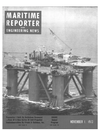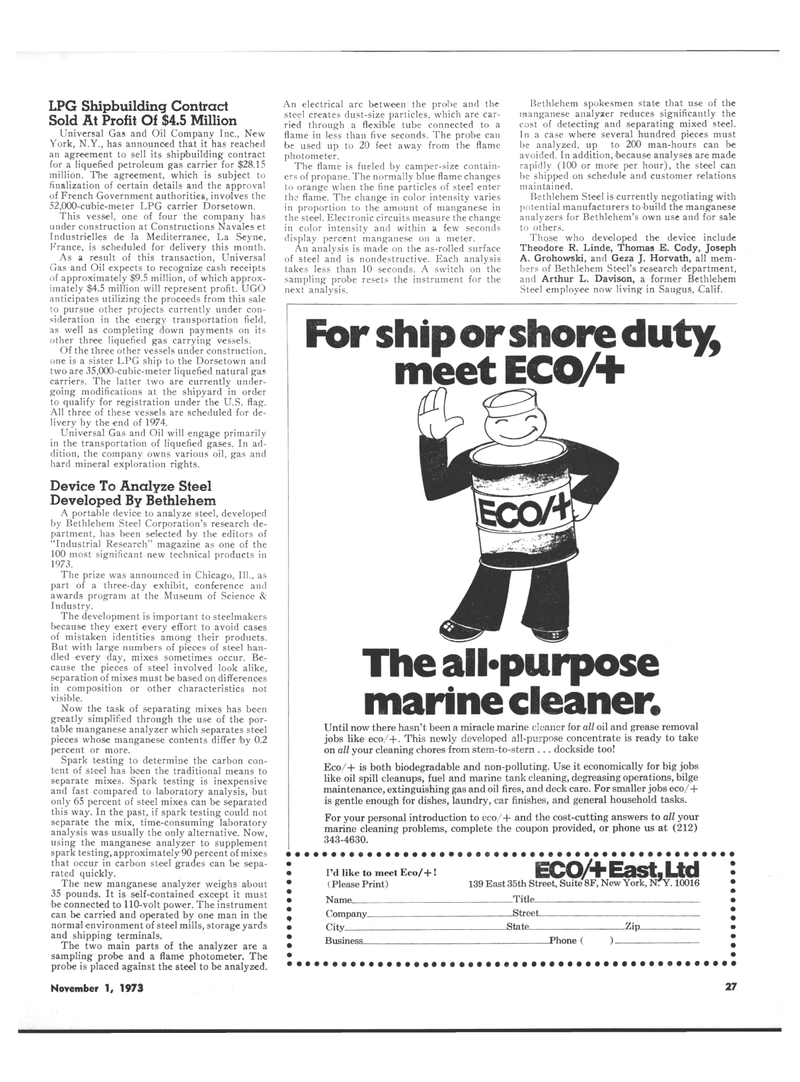
Page 21: of Maritime Reporter Magazine (November 1973)
Read this page in Pdf, Flash or Html5 edition of November 1973 Maritime Reporter Magazine
LPG Shipbuilding Contract
Sold At Profit Of $4.5 Million
Universal Gas and Oil Company Inc., New
York, N.Y., has announced that it has reached an agreement to sell its shipbuilding contract for a liquefied petroleum gas carrier for $28.15 million. The agreement, which is subject to finalization of certain details and the approval of French Government authorities, involves the 52,000-cubic-meter LPG carrier Dorsetown.
This vessel, one of four the company has under construction at Constructions Navales et
Industrielles de la Mediterranee, La Seyne,
France, is scheduled for delivery this month.
As a result of this transaction, Universal
Gas and Oil expects to recognize cash receipts of approximately $9.5 million, of which approx- imately $4.5 million will represent profit. UGO anticipates utilizing the proceeds from this sale to pursue other projects currently under con- sideration in the energy transportation field, as well as completing down payments on its other three liquefied gas carrying vessels.
Of the three other vessels under construction, one is a sister LPG ship to the Dorsetown and two are 35,000-cubic-meter liquefied natural gas carriers. The latter two are currently under- going modifications at the shipyard in order to qualify for registration under the U.S. flag.
All three of these vessels are scheduled for de- livery by the end of 1974.
Universal Gas and Oil will engage primarily in the transportation of liquefied gases. In ad- dition, the company owns various oil, gas and hard mineral exploration rights.
Device To Analyze Steel
Developed By Bethlehem
A portable device to analyze steel, developed by Bethlehem Steel Corporation's research de- partment, has been selected by the editors of "Industrial Research" magazine as one of the 100 most significant new technical products in 1973.
The prize was announced in Chicago, 111., as part of a three-day exhibit, conference and awards program at the Museum of Science &
Industry.
The development is important to steelmakers because they exert every effort to avoid cases of mistaken identities among their products.
But with large numbers of pieces of steel han- dled every day, mixes sometimes occur. Be- cause the pieces of steel involved look alike, separation of mixes must be based on differences in composition or other characteristics not visible.
Now the task of separating mixes has been greatly simplified through the use of the por- table manganese analyzer which separates steel pieces whose manganese contents differ by 0.2 percent or more.
Spark testing to determine the carbon con- tent of steel has been the traditional means to separate mixes. Spark testing is inexpensive and fast compared to laboratory analysis, but only 65 percent of steel mixes can be separated this way. In the past, if spark testing could not separate the mix, time-consuming laboratory analysis was usually the only alternative. Now, using the manganese analyzer to supplement spark testing, approximately 90 percent of mixes that occur in carbon steel grades can be sepa- rated quickly.
The new manganese analyzer weighs about 35 pounds. It is self-contained except it must 'be connected to 110-volt power. The instrument can be carried and operated by one man in the normal environment of steel mills, storage yards and shipping terminals.
The two main parts of the analyzer are a sampling probe and a flame photometer. The probe is placed against the steel to be analyzed.
An electrical arc between the probe and the steel creates dust-size particles, which are car- ried through a flexible tube connected to a flame in less than five seconds. The probe can be used up to 20 feet away from the flame photometer.
The flame is fueled by camper-size contain- ers of propane. The normally blue flame changes to orange when the fine particles of steel enter the flame. The change in color intensity varies in proportion to the amount of manganese in the steel. Electronic circuits measure the change in color intensity and within a few seconds display percent manganese on a meter.
An analysis is made on the as-rolled surface of steel and is nondestructive. Each analysis takes less than 10 seconds. A switch on the sampling probe resets the instrument for the next analysis.
Bethlehem spokesmen state that use of the manganese analyzer reduces significantly the cost of detecting and separating mixed steel.
In a case where several hundred pieces must be analyzed, up to 200 man-hours can be avoided. In addition, because analyses are made rapidly (100 or more per hour), the steel can be shipped on schedule and customer relations maintained.
Bethlehem Steel is currently negotiating with potential manufacturers to build the manganese analyzers for Bethlehem's own use and for sale to others.
Those who developed the device include
Theodore R. Linde, Thomas E. Cody, Joseph
A. Grohowski, and Geza J. Horvath, all mem- bers of Bethlehem Steel's research department, and Arthur L. Davison, a former Bethlehem
Steel employee now living in Saugus, Calif.
For ship or shore duty, meet ECO/+
The alhpurpose marine cleaner.
Until now there hasn't been a miracle marine cleaner for all oil and grease removal jobs like eco/+. This newly developed all-purpose concentrate is ready to take on all your cleaning chores from stem-to-stern .. . dockside too!
Eco/+ is both biodegradable and non-polluting. Use it economically for big jobs like oil spill cleanups, fuel and marine tank cleaning, degreasing operations, bilge maintenance, extinguishing gas and oil fires, and deck care. For smaller jobs eco/+ is gentle enough for dishes, laundry, car finishes, and general household tasks.
For your personal introduction to eco/+ and the cost-cutting answers to all your marine cleaning problems, complete the coupon provided, or phone us at (212) 343-4630.
I'd like to meet Eco/+ ! SECO/t EdStj Ltd (Please Print) 139 East 35th Street, Suite 8F, New York, N. Y. 10016
Name Title __
Company Street
City— State Zip_
Business . Phone ( )
November 1, 1973 27

 20
20

 22
22
